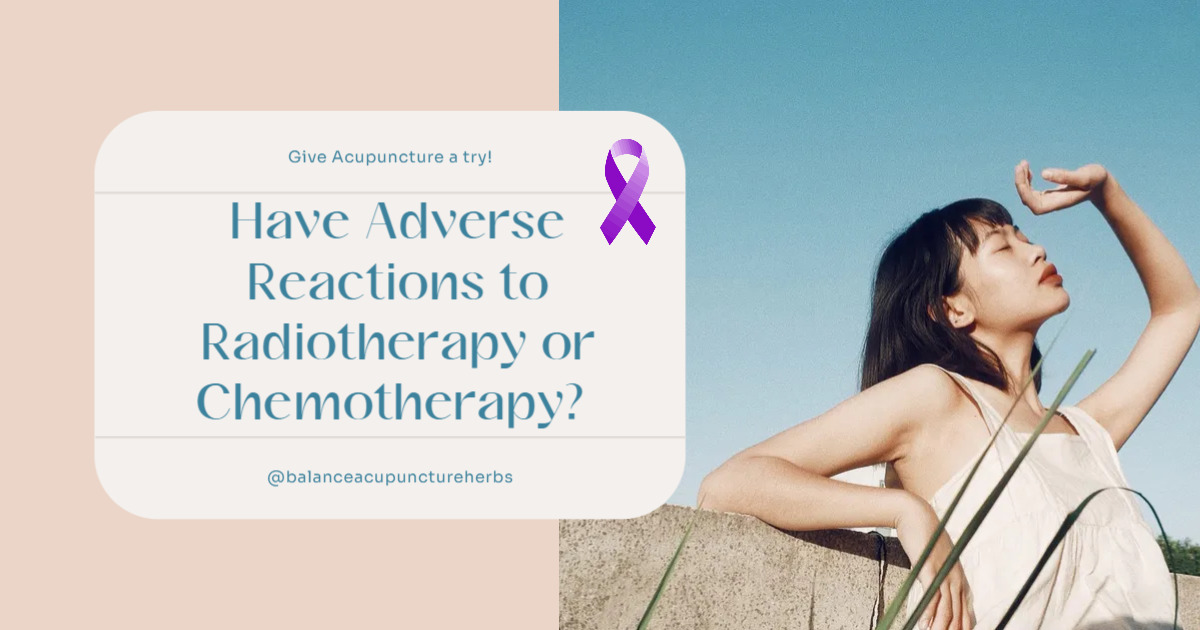
Allergic rhinitis is recurrent. Why not try acupuncture?
July 14, 2022
Have Adverse Reactions to Radiotherapy or Chemotherapy? Give Acupuncture a Try!
September 14, 2022|
Getting your Trinity Audio player ready...
|
Does Acupuncture Work for Dysmenorrhea?
Dysmenorrhea is an abdominal pain accompanying cyclical menstrual cramps, most commonly in young or adolescent women. The abdominal pain is mainly distention and colic; in severe cases, the pain can radiate to the lumbosacral region, inner thigh, and anus. In extreme cases, some patients may be accompanied by systemic symptoms such as nausea and vomiting, abdominal pain, diarrhea, headache, dizziness, and even fainting, which greatly distress the patients. Dysmenorrhea will also pressure patients psychologically with the repeated menstrual cycle, seriously affecting daily work and study.
Does acupuncture work for dysmenorrhea?
Acupuncture therapy is an essential part of traditional Chinese medicine (TCM). Acupuncture has also been used to treat dysmenorrhea since ancient times.
With the deepening of modern research, more and more clinical evidence shows acupuncture is effective in treating menstrual abdominal pain, especially for primary dysmenorrhea. Moreover, acupuncture treatment has excellent advantages. In a review and analysis of dozens of randomized controlled clinical trials, researchers found that acupuncture was effective as non-steroidal anti-inflammatory drugs (NSAIDs) in improving menstrual abdominal pain and other accompanying symptoms. And its analgesic effect was comparable to that of NSAIDs. Premenstrual acupuncture treatment can also prevent the onset of dysmenorrhea to a certain extent.
Treatment
Acupuncture:
It is recommended that patients with dysmenorrhea should usually be treated with Chinese herbal medicine combined with acupuncture. Increase the number of acupuncture treatments after ovulation, and still use acupuncture when the menstrual period is uncomfortable to reduce the symptoms.
Read more : Step of acupuncture treatment
Chinese Herbal Medicine:
Our practitioners will depend on your syndrome to customize your herbal medicine prescription.
Offer in-person and online herbal medicine treatment.
Supplements:
Supplements of Dysmenorrhea are in our online dispensary. Create an account.
How do daily health care?
- Exercise: Moderate weekday exercise can increase physical resistance, such as yoga, swimming, Tai Chi, and Qigong.
- Mood: Maintain a good attitude, relieve stress, and reduce symptoms of dysmenorrhea.
- Habits: Three meals, adequate relaxation.
How do to relieve the menstrual pain?
- Avoid raw and cold foods before and during menstruation, such as napa Cabbage, bitter gourd, banana, watermelon, green tea, and chrysanthemum.
- When menstruation is painful, massage acupuncture points to relieve symptoms. Common acupoints include Xuehai acupoint on the thigh and Sanyinjiao acupoint on the lower leg. Massage the acupoints with your thumb for 3-5 minutes. Or contact your acupuncturist to schedule a treatment appointment.
- On weekdays, you can take diet therapy for health care according to your constitution. For kidney deficiency patterns, you can drink mulberry and red dates tea. For blood deficiency type, you can drink dried longan pulp and red jujube water; for qi stagnation syndrome, you can drink rose tea; for deficiency-cold type, you can drink black bean, ginger, and brown sugar water.
Read more: Relieve Menopause Symptoms with Acupuncture
Reference:
Woo, Hye Lin et al. “The efficacy and safety of acupuncture in women with primary dysmenorrhea: A systematic review and meta-analysis.” Medicine vol. 97,23 (2018): e11007. doi:10.1097/MD.0000000000011007
Shetty, Geetha B et al. “Efficacy of Acupuncture in the Management of Primary Dysmenorrhea: A Randomized Controlled Trial.” Journal of acupuncture and meridian studies vol. 11,4 (2018): 153-158. doi:10.1016/j.jams.2018.04.001
Guimarães, Inês, and Ana Margarida Póvoa. “Primary Dysmenorrhea: Assessment and Treatment.” “Dismenorreia primária: Avaliação e tratamento.” Revista brasileira de ginecologia e obstetricia : revista da Federacao Brasileira das Sociedades de Ginecologia e Obstetricia vol. 42,8 (2020): 501-507. doi:10.1055/s-0040-1712131
Hou, Xue-Si et al. Zhongguo zhen jiu = Chinese acupuncture & moxibustion vol. 40,8 (2020): 834-8. doi:10.13703/j.0255-2930.20190630-0002
Guo, Ying et al. “Complementary and Alternative Medicine for Dysmenorrhea Caused by Endometriosis: A Review of Utilization and Mechanism.” Evidence-based complementary and alternative medicine : eCAM vol. 2021 6663602. 2 Jul. 2021, doi:10.1155/2021/6663602
Xu, Donghan et al. “Intradermal acupuncture for primary dysmenorrhea: A protocol of systematic review and meta-analysis of randomized clinical trials.” Medicine vol. 99,37 (2020): e22188. doi:10.1097/MD.0000000000022188
Wu, Zenan et al. “Which acupuncture and moxibustion technique is more effective for primary dysmenorrhea: A protocol for a network meta-analysis of randomized controlled trials.” Medicine vol. 99,35 (2020): e21713. doi:10.1097/MD.0000000000021713




